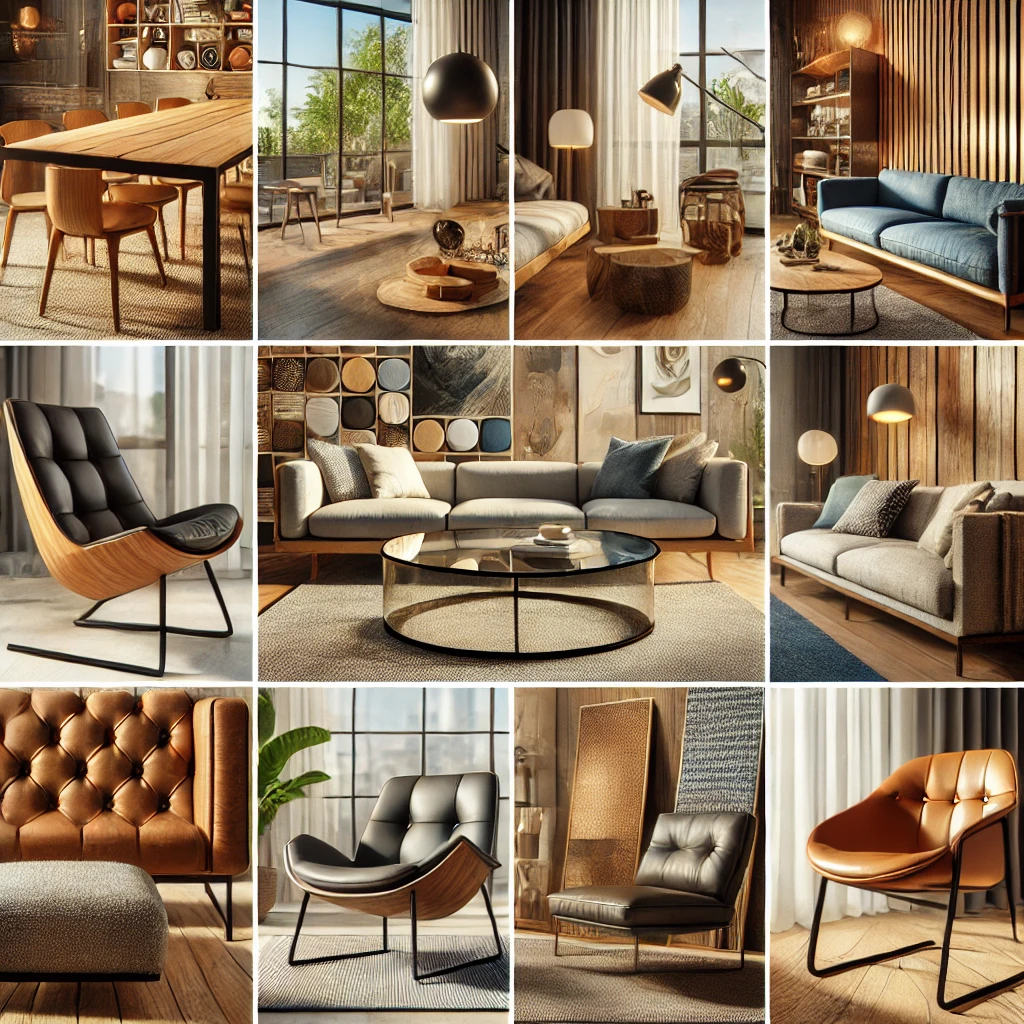When purchasing furniture, the material plays a significant role in determining its durability, aesthetics, and overall functionality. From traditional wood to modern synthetic materials, furniture construction materials vary widely, each with distinct advantages and limitations. Below is a guide to the most popular materials used in furniture, and insights into which might be the best choice for you based on different factors like style, longevity, and usage.
Wood: A Timeless Classic
Types of Wood:
- Hardwoods: Oak, Maple, Cherry, Mahogany
- Softwoods: Pine, Cedar
Advantages:
- Durability: Hardwoods like oak and mahogany are long-lasting and resistant to wear, making them ideal for high-use pieces like dining tables or chairs.
- Aesthetic Appeal: Wood’s natural grains add warmth and beauty, and it can be stained or painted in various finishes to match décor styles.
- Sustainability: Responsibly sourced wood is an eco-friendly option as it is renewable and biodegradable.
Disadvantages:
- Cost: Solid hardwood furniture can be expensive.
- Maintenance: Requires periodic polishing or refinishing to maintain its appearance.
Best For: Those seeking durability and a classic, elegant look in their furniture.
Metal: Sleek and Modern
Common Types of Metal:
- Steel: Common for bed frames, shelving, and office furniture.
- Aluminum: Lightweight, often used in modern or minimalist furniture.
- Wrought Iron: Typically found in outdoor furniture or intricate designs.
Advantages:
- Strength: Metal furniture, especially steel, is incredibly strong and can withstand heavy use.
- Modern Aesthetic: Offers a sleek, industrial look that fits contemporary or minimalist décor.
- Low Maintenance: Resistant to wear, rust (if treated), and damage.
Disadvantages:
- Cold Appearance: Some people find metal too harsh or cold for certain living spaces.
- Weight: Steel and iron can be heavy and difficult to move.
Best For: Industrial, modern, or minimalist interiors; high-traffic areas that require durable furniture.
Glass: Sophistication and Elegance
Common Uses: Dining tables, coffee tables, desk surfaces.
Advantages:
- Elegance: Glass adds a sleek, luxurious feel to any room, making it perfect for contemporary or upscale settings.
- Versatility: Pairs well with other materials like wood, metal, or stone for a hybrid look.
Disadvantages:
- Fragility: While tempered glass is more durable, it can still break or chip under force.
- Maintenance: Prone to fingerprints, smudges, and scratches, requiring regular cleaning.
Best For: Dining areas, coffee tables, or as accent pieces in rooms aiming for a modern or elegant look.
Plastic: Affordable and Adaptable
Common Types: Polypropylene, PVC, Acrylic
Advantages:
- Affordability: Plastic furniture is typically inexpensive and lightweight, making it a budget-friendly option.
- Versatility: Available in various colors, shapes, and finishes, plastic can suit a wide range of aesthetics from playful to modern.
- Weather-Resistant: Particularly useful for outdoor furniture due to its resistance to water and sunlight.
Disadvantages:
- Less Durable: Plastic is prone to cracking or fading over time, particularly with heavy use or exposure to harsh environments.
- Aesthetic Limitation: Plastic can sometimes look cheap or overly synthetic.
Best For: Outdoor spaces, children’s rooms, or lightweight, portable furniture solutions.
Fabric: Comfort and Style
Common Types: Cotton, Linen, Polyester, Velvet, Leather (also considered under upholstery)
Advantages:
- Comfort: Fabric upholstery adds a level of comfort unmatched by most other materials, making it ideal for seating and lounge furniture.
- Design Flexibility: Available in an array of patterns, colors, and textures, fabric can adapt to various interior styles from casual to formal.
- Affordable Options: Fabric can range from inexpensive synthetics to luxurious natural fibers, offering options for various budgets.
Disadvantages:
- Maintenance: Prone to stains, odors, and wear, requiring regular cleaning or professional treatment.
- Durability: Depending on the type of fabric, some may wear down faster, especially in high-traffic areas.
Best For: Living rooms, bedrooms, and anywhere comfort is prioritized over durability.
Leather: Luxury and Longevity
Types:
- Full-grain Leather: Highest quality, thick, and durable.
- Top-grain Leather: Slightly lower in quality but still luxurious.
- Faux Leather: Synthetic version, cheaper but less durable.
Advantages:
- Durability: Genuine leather, particularly full-grain, can last decades with proper care.
- Timeless Appeal: Leather adds a sophisticated, luxurious look to any space.
- Low Maintenance: Easy to clean (wipe spills) and resistant to dust and allergens.
Disadvantages:
- Cost: High-quality leather is expensive.
- Temperature Sensitivity: Can become hot in summer and cold in winter, making it less comfortable in certain climates.
Best For: High-end, luxurious interiors, or those looking for long-lasting, stylish seating solutions.
Which Material Is Best?
The best furniture material depends largely on your individual needs, preferences, and the intended use of the furniture.
- For Durability: Solid wood and metal are the most long-lasting, particularly for furniture expected to endure heavy use.
- For Comfort: Fabric or leather upholstery is best for seating, especially in living rooms or bedrooms.
- For Outdoor Use: Plastic and treated metal are optimal due to their weather-resistant properties.
- For Modern Aesthetics: Glass, metal, or plastic offer sleek, minimalist designs ideal for contemporary homes.
- For Budget-Friendly Options: Plastic and synthetic fabric offer affordability without sacrificing versatility.
Ultimately, the “best” material is one that aligns with your style, functionality requirements, and lifestyle. Opt for materials that meet the specific needs of your living space while enhancing your overall home design.


Leave a Reply